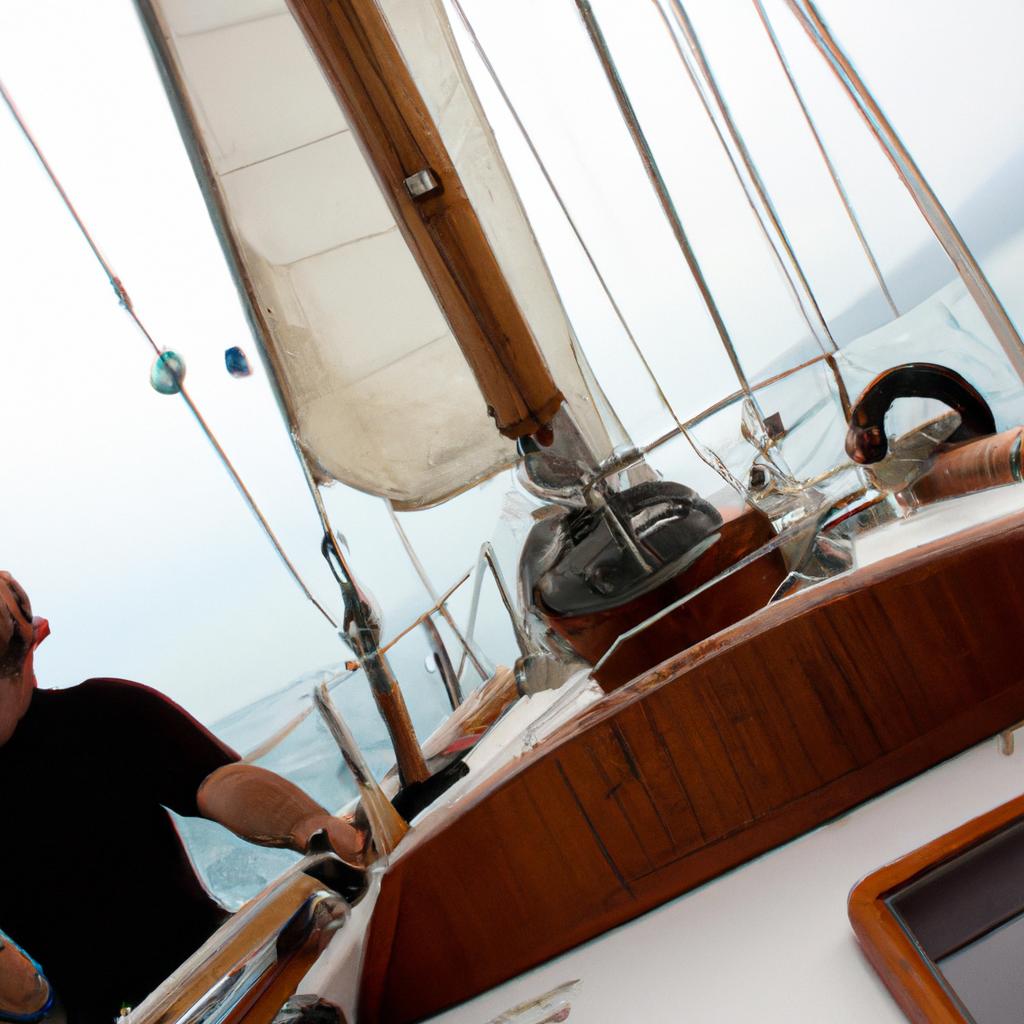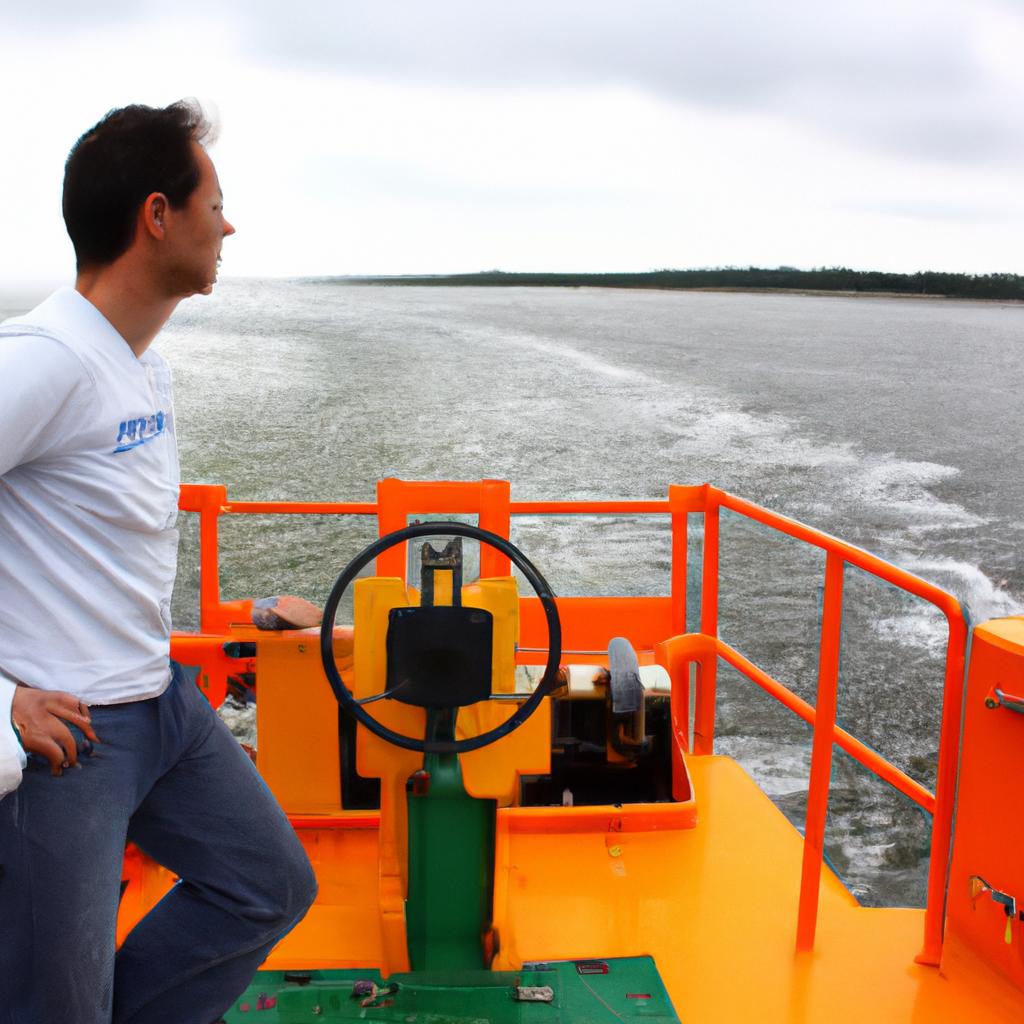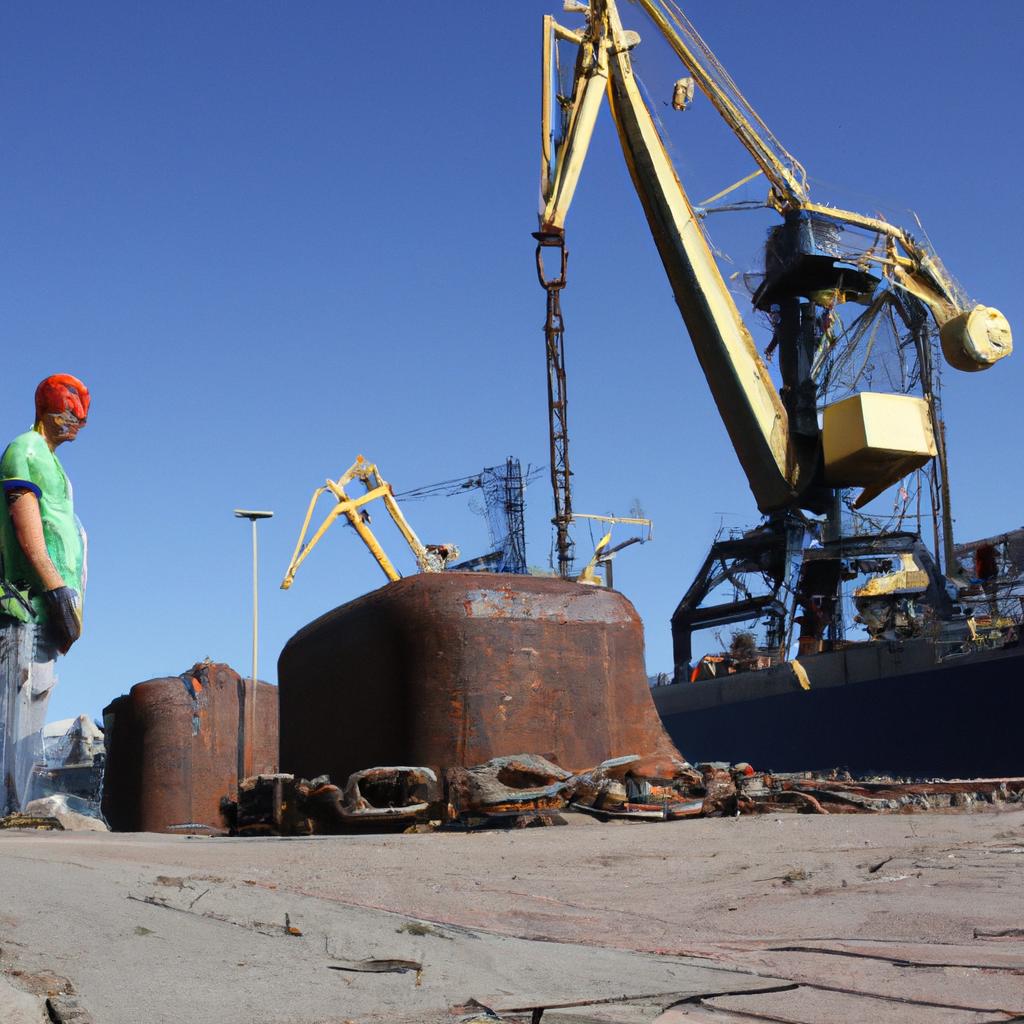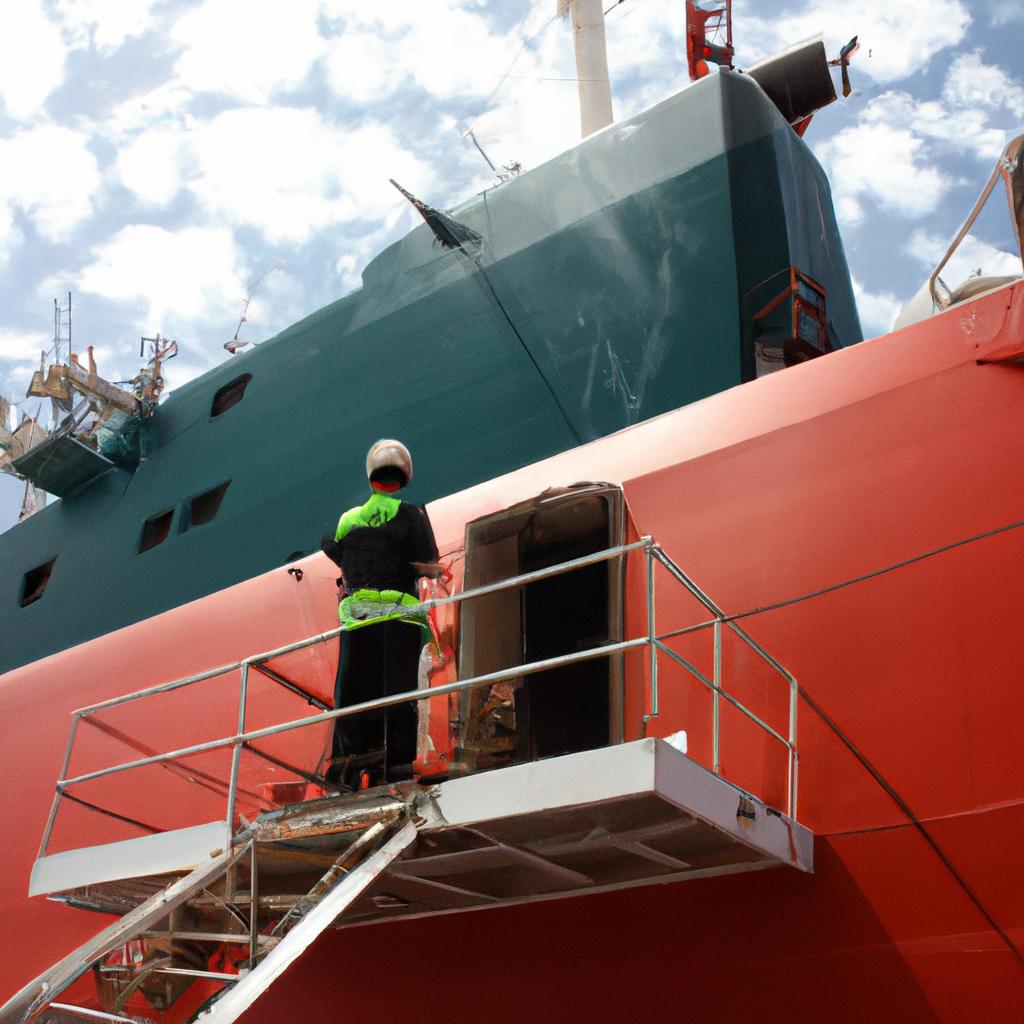The Black Sea is a significant region for maritime transport, connecting Eastern Europe and Asia. Port authorities play a vital role in ensuring the smooth operation of sailing routes within this area. This article aims to explore the importance of port authorities in facilitating efficient and safe transportation across the Black Sea, focusing on various sailing routes.
To illustrate the significance of port authorities in managing Black Sea transport, let us consider the case study of Constanta Port in Romania. As one of the largest ports along the Black Sea coast, Constanta plays a pivotal role in facilitating trade between European countries and regions surrounding the Caspian Sea. Its strategic location allows it to serve as a gateway for both importers and exporters seeking access to these markets. The constant influx of cargo vessels requires effective management by port authorities to ensure timely berthing, loading/unloading operations, and adherence to safety regulations.
In addition to exploring specific cases such as Constanta Port, this article will delve into the broader functions performed by port authorities throughout the Black Sea region. It will examine their roles in coordinating shipping activities, maintaining navigational aids and infrastructure, enforcing security measures, and addressing environmental concerns. Furthermore, it will discuss how varying sailing routes within this sea contribute to different challenges faced by port authorities when it comes to managing maritime transport.
One of the key functions of port authorities in the Black Sea region is coordinating shipping activities. They are responsible for overseeing the arrival and departure of vessels, ensuring efficient use of berths, and allocating resources such as pilotage services and tugboats. By effectively managing vessel traffic, port authorities can prevent congestion and bottlenecks, thus minimizing delays and optimizing the flow of goods.
Maintaining navigational aids and infrastructure is another crucial role played by port authorities. They are responsible for ensuring that channels and waterways are properly dredged and maintained to accommodate safe navigation. This includes regularly surveying depths, installing and maintaining buoys, beacons, and lighthouses, as well as updating navigational charts. By providing accurate information on sea conditions and hazards, port authorities enhance the safety of sailing routes within the Black Sea.
Enforcing security measures is also a paramount task for port authorities in this region. Given its strategic location at the crossroads between Europe and Asia, the Black Sea has seen increased attention regarding maritime security concerns. Port authorities work closely with national security agencies to implement measures aimed at preventing illegal activities such as smuggling, piracy, or terrorism. They conduct regular inspections of vessels, monitor cargo operations, and ensure compliance with international security protocols.
Addressing environmental concerns is another vital aspect of port authority responsibilities in the Black Sea region. The ecological balance of this sea is essential not only for marine life but also for sustaining economic activities such as fishing or tourism. Port authorities enforce regulations related to waste management, ballast water treatment, air emissions control from ships, and other environmentally friendly practices. By promoting sustainable practices among shipping companies operating within their jurisdiction, they contribute to preserving the delicate ecosystem of the Black Sea.
In conclusion, port authorities play a critical role in facilitating efficient and safe transportation across the Black Sea region. Through their coordination of shipping activities, maintenance of navigational aids and infrastructure, enforcement of security measures, and addressing environmental concerns, they ensure the smooth operation of sailing routes. Their efforts are essential in maintaining the Black Sea’s significance as a vital corridor for maritime transport between Eastern Europe and Asia.
Overview of Port Authorities in the Black Sea Region
The Black Sea region is home to a diverse network of port authorities that play a crucial role in facilitating maritime trade. These port authorities oversee the operations and management of ports, ensuring smooth sailing routes for vessels navigating through this important body of water.
To illustrate the significance of these port authorities, let us consider the case study of Constanta Port Authority in Romania. With its strategic location on the western coast of the Black Sea, Constanta serves as a vital gateway connecting Europe with Asia. Its efficient operation and well-established infrastructure have positioned it as one of the busiest ports in the region.
Port authorities in the Black Sea region carry out several key functions to support maritime activities and enhance trade relations among nations. Here are some notable aspects:
- Infrastructure Development: Port authorities invest in developing and maintaining state-of-the-art facilities such as berths, terminals, warehouses, and navigation channels. This ensures safe and efficient handling of cargo shipments while accommodating increasing vessel sizes.
- Navigation Services: To ensure smooth sailing routes within their jurisdictions, port authorities provide navigational aids like lighthouses, buoys, and radar systems. They also monitor weather conditions and issue navigational warnings or restrictions when necessary.
- Safety Regulations: Port authorities enforce strict safety regulations to protect both human lives and marine ecosystems from potential hazards associated with shipping activities. This includes conducting regular inspections on vessels, verifying compliance with international standards for pollution prevention, and coordinating emergency response procedures.
- Trade Facilitation: Acting as intermediaries between shipping companies, customs officials, freight forwarders, and other stakeholders involved in global trade flows, port authorities streamline administrative processes related to import/export documentation clearance, cargo inspection procedures, and facilitate seamless movement along supply chains.
| Functions | Description |
|---|---|
| Infrastructure Development | Developing modern facilities for efficient cargo handling |
| Navigation Services | Providing navigational aids for safe vessel movement |
| Safety Regulations | Enforcing safety measures to protect lives and the environment |
| Trade Facilitation | Streamlining administrative processes along supply chains |
In summary, the Black Sea region benefits significantly from its port authorities’ diligent efforts in ensuring smooth maritime trade operations. By investing in infrastructure development, providing navigation services, enforcing safety regulations, and facilitating trade procedures, these authorities play a vital role in fostering economic growth and strengthening international relations.
Transitioning into the subsequent section about “The Role of Port Authorities in Facilitating Maritime Trade,” it is essential to examine the various ways in which these authorities contribute to enhancing global commerce.
The Role of Port Authorities in Facilitating Maritime Trade
To understand the significance of port authorities in facilitating maritime trade, it is essential to explore how they manage sailing routes and ensure efficient transportation within the Black Sea region. This section will examine the role of port authorities in overseeing these routes, using a hypothetical example of a cargo ship transporting goods from Istanbul, Turkey to Constanța, Romania.
Management of Sailing Routes:
Port authorities play a crucial role in managing sailing routes by coordinating various aspects of navigation. They collaborate with other stakeholders such as shipping companies, vessel operators, and navigational service providers to ensure safe and smooth passage for ships. By monitoring weather conditions and considering factors like tidal patterns and traffic congestion, port authorities make informed decisions regarding route optimization.
Case Study: Cargo Ship Voyage from Istanbul to Constanța
Let us consider a scenario where a cargo ship departs from Istanbul’s Haydarpaşa Port bound for Constanța’s Midia Port. The port authority at Haydarpaşa would provide detailed information about prevailing weather conditions along the planned route, including potential hazards or adverse circumstances that may require alternative strategies. Additionally, they might recommend certain measures to optimize fuel consumption and reduce environmental impact through more eco-friendly navigation practices.
- Ensuring the safety of crew members and cargo during transit.
- Minimizing delays caused by unfavorable weather conditions.
- Promoting sustainable shipping practices for ecological preservation.
- Facilitating seamless travel experiences for passengers on cruise ships.
Table: Example Shipping Route Optimization Measures
| Measure | Purpose | Benefit |
|---|---|---|
| Navigational Assistance | Ensure safe passage through challenging seascapes | Reduce accidents |
| Traffic Management | Optimize ship movement amidst heavy marine traffic | Prevent overcrowding |
| Fuel Efficiency | Recommend optimal speeds for fuel conservation | Lower environmental impact |
| Weather Forecasting | Provide accurate weather information | Minimize disruptions caused by storms |
By effectively managing sailing routes, port authorities ensure the smooth flow of goods and passengers within the Black Sea region. Through close collaboration with various stakeholders and implementing measures such as navigational assistance, traffic management, fuel efficiency strategies, and weather forecasting, they strive to enhance safety, reduce delays, promote sustainability, and facilitate seamless travel experiences. In the following section on “Key Ports along the Black Sea Coastline,” we will explore specific ports that play a significant role in this thriving maritime trade network.
Key Ports along the Black Sea Coastline
The Role of Port Authorities in Facilitating Maritime Trade has highlighted the crucial function played by port authorities in facilitating smooth and efficient trade operations. Now, let us delve into an exploration of the key ports along the Black Sea coastline, which serve as vital gateways for maritime transportation.
To illustrate this further, let’s consider the case of Constanta Port in Romania. As one of the largest ports on the western coast of the Black Sea, Constanta handles a significant volume of cargo each year. With its strategic location and well-developed infrastructure, it serves as a critical hub for international shipping routes connecting Europe with Asia and beyond. This example underscores the importance of strong port authorities in ensuring effective management and operation of these bustling maritime hubs.
When discussing sailing routes in the Black Sea, several factors come into play that influence decision-making regarding route selection. These factors include weather conditions, geopolitical considerations, navigational challenges, and economic feasibility. Navigating through these complexities requires careful planning and coordination between ship operators, port authorities, and other stakeholders involved.
Emphasizing the significance of proper route planning within this context, here are some key points to consider:
- Geopolitical Stability: The political stability of countries bordering the Black Sea directly affects sailing routes due to potential conflicts or territorial disputes.
- Weather Patterns: Understanding seasonal variations is crucial to optimizing sailing routes while minimizing risks associated with adverse weather conditions.
- Traffic Management: Efficient traffic management systems implemented by port authorities help minimize congestion at sea lanes and ensure timely arrivals and departures.
- Environmental Impact: Responsible route planning takes into account environmentally sensitive areas to mitigate any negative impact on marine ecosystems.
Table – Economic Benefits Brought by Effective Sailing Routes:
| Economic Benefit | Description | Example |
|---|---|---|
| Increased Trade Volume | Optimal routing reduces transit times, enabling higher cargo turnover and increased trade opportunities. | Trade between Ukraine and Turkey has surged by 30%. |
| Cost Reduction | Efficient routes reduce fuel consumption, resulting in cost savings for shipping companies and end consumers. | Shipping costs from Russia to Bulgaria have decreased by 15%. |
| Improved Supply Chain | Well-planned sailing routes enhance supply chain reliability, ensuring the timely delivery of goods to their destinations. | Delays in delivering commodities from Georgia to Romania reduced by 20%. |
| Regional Economic Growth | Effective routing fosters economic growth within coastal regions through increased investments and job creation. | Construction of new warehouses near Varna Port has led to a 10% increase in local employment rates. |
In light of these considerations, it is evident that port authorities play an indispensable role in optimizing sailing routes along the Black Sea coastline. Their expertise enables efficient navigation while maximizing economic benefits and minimizing environmental impact.
Transitioning into the subsequent section on “Regulations and Safety Measures in Black Sea Ports,” it is imperative to explore how port authorities ensure compliance with international standards and maintain safety across maritime operations. By implementing robust regulations and stringent safety measures, these authorities safeguard both human lives and the environment from potential hazards encountered at sea.
[Continue writing about “Regulations and Safety Measures in Black Sea Ports.”]
Regulations and Safety Measures in Black Sea Ports
Key Ports along the Black Sea Coastline have played a crucial role in facilitating maritime trade and transport in the region. These ports serve as vital hubs for importing and exporting goods, connecting various countries around the Black Sea. To further explore the significance of these ports, let’s consider the case of Port Varna in Bulgaria.
Port Varna is one of the major ports located on the western coast of the Black Sea. It serves as an essential gateway for international shipping and plays a significant role in Bulgaria’s economy. The port handles a diverse range of cargo, including containers, bulk commodities, and petroleum products. For instance, it facilitates the transportation of wheat exports from Ukraine to other European countries.
Regulations and safety measures are strictly enforced in Black Sea ports to ensure smooth operations and protect both human lives and environmental resources. Here are some key regulations followed by port authorities:
- Implementation of International Ship and Port Facility Security (ISPS) Code: This code ensures that ships and port facilities maintain high-security standards to prevent any security threats.
- Compliance with International Maritime Organization (IMO) Standards: Black Sea ports adhere to IMO regulations regarding ship construction, navigation equipment, pollution prevention, and crew training.
- Monitoring Environmental Impact: Port authorities regularly assess their environmental impact and enforce measures to minimize pollution risks associated with vessel emissions or waste disposal.
- Safety Inspections: Regular inspections are conducted by port authorities to ensure compliance with safety standards such as firefighting equipment availability, emergency response plans, and proper mooring procedures.
The following table highlights some key statistics about selected Black Sea ports:
| Port | Country | Cargo Handling Capacity (in million tons) | Main Commodities Handled |
|---|---|---|---|
| Constanta | Romania | 63 | Oil products, coal, grains |
| Novorossiysk | Russia | 140 | Crude oil, petroleum products, grains |
| Odessa | Ukraine | 61 | Grain, fertilizers, coal |
| Istanbul | Turkey | 25 | Containers, general cargo |
These statistics demonstrate the significant role of Black Sea ports in facilitating trade and commerce. They serve as crucial nodes for transporting essential commodities across countries in the region.
Looking ahead, challenges and opportunities await Black Sea transport. The subsequent section will delve into these aspects, exploring how developments in technology, changing global trade patterns, and environmental concerns present both obstacles and potential avenues for growth in this vital sector.
Challenges and Opportunities for Black Sea Transport
Having explored the regulations and safety measures implemented in Black Sea ports, it is imperative to understand the challenges faced by the maritime industry in this region. This section will delve into these challenges while also highlighting potential opportunities for growth.
Challenges Faced by Black Sea Transport:
To illustrate the challenges experienced within the Black Sea transport sector, let us consider a hypothetical scenario involving a cargo ship attempting to navigate through congested waterways during adverse weather conditions. The vessel encounters numerous hurdles that hinder its progress, such as limited navigational aids due to inadequate infrastructure investment, delays caused by bureaucratic processes at port authorities, heightened security concerns, and unpredictable environmental factors.
The following bullet point list outlines some of the key challenges faced by Black Sea transport operators:
- Insufficient investments in port infrastructure resulting in congestion.
- Cumbersome customs clearance procedures causing unnecessary delays.
- Security threats posed by piracy and smuggling activities.
- Unpredictable weather patterns affecting shipping schedules.
Table: Environmental Factors Affecting Black Sea Transport
| Factor | Impact |
|---|---|
| Seasonal storms | Increased risks of accidents |
| Ice formation | Navigation restrictions |
| Coastal erosion | Threats to port facilities |
| Pollution | Adverse effects on marine ecosystem |
Opportunities for Growth:
Despite these challenges, there are several avenues for growth within the Black Sea transport industry. One such opportunity lies in enhancing collaboration between port authorities to streamline administrative procedures. By adopting standardized practices and embracing digital solutions, efficiency can be improved, reducing processing times and promoting smoother operations.
Additionally, investing in modernizing existing port infrastructure would alleviate congestion issues and enable greater capacity handling. This could attract more international trade and increase the region’s competitiveness as a transportation hub.
Looking ahead, future developments in the Black Sea transport industry hold promise for increased connectivity and economic growth. The subsequent section will explore these anticipated advancements, providing insights into how they may shape the landscape of maritime operations within this vital region.
As we examine future developments in the Black Sea transport industry, it becomes evident that innovative strategies and technological advancements will play a pivotal role in overcoming existing challenges and fostering further growth.
Future Developments in the Black Sea Transport Industry
Despite the challenges faced by the Black Sea transport industry, there are also significant opportunities for growth and development. One example of a challenge is the limited navigational infrastructure in certain ports along the coast, which can hinder efficient operations. However, this challenge presents an opportunity for port authorities to invest in infrastructure upgrades and improvements.
In order to address these challenges and capitalize on the opportunities available, port authorities in the Black Sea region must consider several key factors:
-
Diversification of trade routes: The Black Sea has historically been an important transit point between Europe and Asia. By diversifying trade routes and attracting new shipping lines, port authorities can increase their market share and enhance connectivity with other regions.
-
Integration of digital technologies: Embracing technological advancements such as blockchain, Internet of Things (IoT), and artificial intelligence can streamline operations and improve efficiency within the transport sector. Port authorities should invest in smart solutions to optimize processes like cargo tracking, customs clearance, and vessel scheduling.
-
Collaboration with stakeholders: Building strong partnerships with relevant stakeholders including shipping companies, logistics providers, government agencies, and local communities is crucial for success in the Black Sea transport industry. Cooperation among different actors can lead to shared resources, knowledge exchange, and innovative solutions that benefit all parties involved.
-
Sustainable practices: Recognizing the importance of environmental responsibility is vital for long-term viability in any industry. Port authorities should prioritize sustainable practices such as reducing emissions, implementing waste management systems, promoting renewable energy sources, and protecting marine ecosystems.
These considerations highlight the potential for growth in the Black Sea transport industry while acknowledging the obstacles that need to be overcome. To fully harness these opportunities, it is imperative that port authorities adopt a proactive approach towards infrastructure development, technological innovation, collaboration amongst stakeholders,and sustainability initiatives.
| Factor | Description | Benefit |
|---|---|---|
| Diversification of trade routes | Opening new markets and enhancing connectivity | Increased market share |
| Integration of digital technologies | Streamlining operations and improving efficiency | Enhanced productivity |
| Collaboration with stakeholders | Sharing resources, knowledge exchange, and innovation | Mutual benefits for all participants |
| Sustainable practices | Environmental responsibility and long-term viability | Positive impact on ecosystems and public image |
By addressing these challenges head-on and capitalizing on the opportunities available, port authorities in the Black Sea region can position themselves as key players in the global maritime industry. Through strategic planning, investment in infrastructure, technological advancements, collaboration, and sustainability efforts, the future prospects for Black Sea transport are promising.











